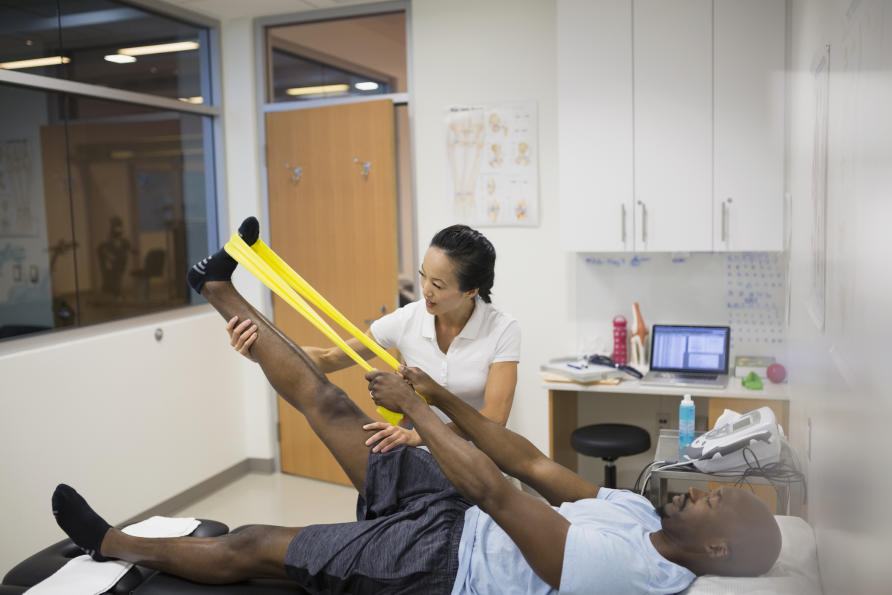How can physios motivate us to do more physical activity?

Despite our international reputation as a sporting nation, the average Aussie doesn’t get enough regular physical activity. And we are paying a heavy price – as many as one in 10 Australian deaths in 2008 were directly attributed to physical inactivity.
Nearly half of us don’t achieve the minimum recommended physical activity levels and Australians with musculoskeletal conditions are even less active, potentially because their condition acts as a barrier.

Government guidelines recommend adults do 75 to 150 minutes of vigorous exercise, like running, or 150-300 minutes of moderate exercise, like walking, every week. On top of this, they recommend muscle strengthening activities at least twice a week.
Physiotherapists have an important role to play in promoting physical activity to patients, especially those with musculoskeletal conditions. But in my PhD research I found that patient expectations, which can be influenced by how clinics are marketed, influence how successfully they can do this.
Imagine you are a physiotherapist and a new patient, Brian, presents to you with shoulder pain. Brian has Type 2 diabetes, is inactive, obese and is not regularly seeing his diabetes educator. Your clinical knowledge tells you that his diabetes is likely to be poorly managed, which might explain his shoulder pain.
As part of his ongoing shoulder management, you plan to give Brian some strategies to increase his physical activity levels, which you know will help manage his diabetes, in turn helping to manage his shoulder pain.
But Brian walked in expecting a shoulder massage.
When the physiotherapist offers advice about exercise instead, it can be like finding raisins in a cookie when you were expecting chocolate chips: disappointing.
Herein lies the challenge.
Modifying patient’s expectations
Let’s start by understanding why Brian might feel disgruntled.

Past experiences can influence patients’ expectations. Brian got a massage when he last saw a physiotherapist for shoulder pain. Naturally, he expects a massage again. He might also think his experience with the physiotherapist as better if he receives a massage – a tangible service – compared to physical activity promotion, an intangible service
So Brian expects a passive treatment, a massage, and not an active treatment that involves more participation on his part, like increasing his physical activity.
Brian might wonder what physical activity has to do with his sore shoulder. Isn’t he seeing a physiotherapist to get his shoulder treated, rather than a lecture on how unfit he is?
This is where the physiotherapist needs to manage Brian’s expectations through clinical reasoning, explaining that addressing his pain requires his active participation with strengthening exercises and physical activity.
The first step is to explain how physical activity, along with other treatments, can help the shoulder pain. So Brian feels his needs are being met, which is necessary for him to feel satisfied with physiotherapy.
But managing patient expectations is not only the role of the physiotherapist.
Let’s talk about marketing
In my study, physiotherapists reported several workplace-specific factors that help them to promote physical activity.
They included having an open-plan space where new patients can see others exercising; informing the community about the benefits of physical activity in, for example, weekly newsletters; and using social media to celebrate the success of patients who lift their fitness levels.

‘Activity-focused’ advertising, like business cards with physical activity-related images, providing information about healthy lifestyles, and using social media to promote the benefits of physical activity, might modify patient expectations so that they expect advice about physical activity.
Similarly, if a clinic advertises massage on the front window, it implies patients can, or will, receive a massage from their physiotherapist. Not advertising a service means patients might not expect to receive it.
In other words, clever marketing can help patients expect physical activity promotion from their physiotherapist – and not just a shoulder massage.
What can clinics do?
One of the barriers for physiotherapists promoting physical activity to their patients is the perception that it is not compatible with their daily practice; physical activity promotion doesn’t seem to ‘fit’ in a typical consultation.
But clinics need to start advertising to potential patients, and to their staff, that physical activity promotion is an important and relevant part of any consultation.
It’s time clinics treat physical activity promotion as a service in its own right and advertise it as such, just like pain management or massage.
Telling patients that physical activity advice is available on clinic windows, business cards and in brochures is a good starting point, as are staff uniforms; who doesn’t want to wear runners and shorts to work?
These strategies can make physical activity promotion easier for their staff.
Clinics need to make their marketing do the hard work so physiotherapists can focus on doing what they do best – restoring and promoting good health.
Dr Kunstler’s research was funded by the Physiotherapy Research Foundation, and this article was written with support from Dr Joanne Kemp (NHMRC Early Career Research Fellow, La Trobe Sport and Exercise Medicine Research Centre) and Dr Alan Labas (Associate Dean [Engagement], Federation Business School, Federation University Australia).
Dr Kunstler is collaborating with Professor Simon Pervan (Professor of Marketing, La Trobe University), Dr Mark Merolli (Academic Director of Digital Health & Informatics, Swinburne University of Technology) and Dr Tanvir Ahmed (Lecturer, La Trobe University) on a survey of Australian adults’ expectations of physiotherapy. The project is at the data collection stage with findings expected to be reported in late 2019. This article was published by Pursuit.
Breanne Kunstler completed her PhD in physical activity promotion by physiotherapists in February 2018. She currently leads, supports and consults on a variety of research projects in her roles as a research fellow at Monash University and the University of Melbourne.














